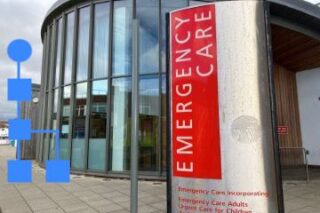Q Exchange
Improving urgent and emergency care flow with simulation modelling
- Proposal
- 2024

Meet the team
Also:
- Alex Curtis, Senior Programme Manager
- Liam Riley, Performance Manager
- Stewart Robinson , Dean and Professor of Operational Research, Newcastle University Business School (Simulation Modelling Advisor)
What is the challenge your project is going to address and how does it connect to the theme of 'How can we improve across system boundaries?
UEC faces several challenges, including increasing demand for services, ensuring timely access to appropriate care for patients, and coordinating care across different services within the system.
Simulation modelling mimics real-world systems. It creates virtual representations of systems, analysing their behaviour under different scenarios. This allows safe experimentation with various parameters and proposed system interventions without affecting the actual system. Simulation modelling can help improve UEC flow by making informed decisions to support:
1. Resource Allocation: simulating patient flow to optimise resource allocation such as staff, beds and equipment ensure efficient use and reducing bottlenecks.
2. Capacity Planning: predicting future UEC demand to support capacity planning, expansion or redesign.
3. Process Optimisation: Simulation modelling allows for safe, ‘virtual PDSA’ testing of proposed process and system change interventions to improve patient flow and reduce waits.
4. Policy Evaluation: Evaluated policies using simulation modelling before implementation to assess potential impact and identify unintended consequences.
What does your project aim to achieve?
There are significant pressures on urgent emergency care. Policymakers have set ambitious targets to treat more patients predicated on working more productively. Understanding the factors contributing to UEC flow and whether it is amenable to intervention will be critical to improving productivity in a sustainable way. Simulation modelling can help analyse patient flow and support decision making by simulating the potential impact of proposed interventions.
Project Objectives are to:
1. Develop a comprehensive simulation model of urgent and emergency care pathways within the NHS, incorporating patient flow, resource utilization, and clinical workflows.
2. Evaluate the impact of different strategies, system change interventions, and policy changes on key performance metrics such as: waiting times; patient care experience and patient outcomes; and resource efficiency.
3. Generate actionable recommendations for optimising urgent and emergency care delivery in the NHS, based on simulation modelling findings and stakeholder input.
How will the project be delivered?
Working with system partners, several initiatives are proposed to support flow and improve UEC performance. Simulation modelling will help identify which initiatives offer the greatest improvement potential enabling robust cost-benefit analysis to support decision making.
To conduct the proposed project, a team will be assembled comprising key skills including:
· Simulation modelling expertise (with local Universities)
· Deep understanding of UEC processes and clinical workflows
· Data analysis expertise to process and analyse the data required for building and validating the simulation model
· Project manager for overseeing the execution of the project and monitoring progress
· Clinical stakeholders and other healthcare professionals who work across the urgent and emergency care system for providing insights, validating assumptions
· Public health and health equity expertise
· Quality improvement expertise to help identify opportunities for process improvement and guide the implementation of changes
· Communication and engagement expertise to facilitate stakeholder engagement and dissemination of findings
How is your project going to share learning?
Our team has a track record of evaluation and dissemination including publication in peer-reviewed journals. We will capture learning pro-actively to produce key learnings that will be re-usable by Q Community members and share this via:
· Q community engagement through Q Exchange events and/or special-interest-group online-events (e.g. webinars and/or tweet chats)
· Share project updates and publishing a final project report online
· Production of a key-learnings sketch-note for sharing via social media
· Summarising our key learning in a Q Community Blog
· Submitting a paper for publication in a BMJ Group journal
How you can contribute
- We’re keen to hear from Qs with any experience of capacity and demand and/or simulation modelling in UEC
- Academic expertise in simulation modelling would be welcome
- Also pathway mapping experiences would be great to about
- Info and thoughts on innovation and new techniques to improve UEC flow
- All contributions welcome
Plan timeline
| 30 Jun 2024 | Project initiation and governance arrangements |
|---|---|
| 31 Jul 2024 | Define Model Objectives and Scope |
| 31 Aug 2024 | Stakeholder engagement, Current state mapping and Data Collection |
| 30 Sep 2024 | Develop the Simulation Model |
| 31 Oct 2024 | Validate the Model |
| 30 Nov 2024 | Scenario Development |
| 31 Jan 2025 | Simulation Experiments |
| 28 Feb 2025 | Analysis and Interpretation |
| 31 Mar 2025 | Recommendations and Action Plan |
| 30 Apr 2025 | Implementation and Evaluation |
| 31 May 2025 | Post implementation review and write-up |
Comments
Paul Rylance 28 Feb 2024
We have sound knowledge in patient flow, delays, capacity and demand. Have a working webtech ED simulator to randomly generates/loads ED's with speciality/triage scenarios. Q membership pending but happy to connect, chat & share thoughts on innovation and new techniques to improve UEC flow
prylance@jkmcaresolutions.co.uk
Iain Smith 6 Mar 2024
Many thanks for sharing, Paul.
Comments are now closed for this post.